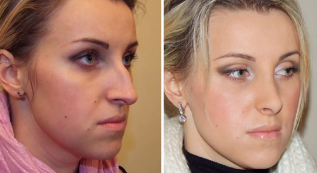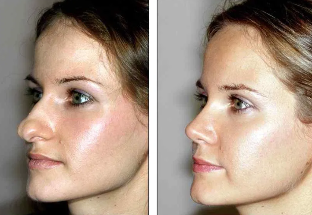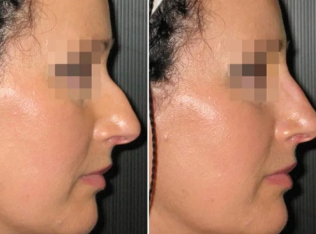Nose correction is one of the most popular plastic surgery, which on Manipulation in the area of the nose. The object of this treatment is to restore the correct shape of the nose, which was broken in the result of injury, disease or congenital pathologies.
The history of the development

Perhaps you feel that rhinoplasty is a new invention, but rather use the services of the surgeon to complete some of the stars and models. It is not so. The first mention of the technique for the restoration of the nose date back to ancient times. Similar operations were to refresh in India 1000 years before our era by Indian doctors, damaged noses, by the skin of the cheek of the patient.
In Europe, Rhino plastic the development in the middle ages. Italian surgeons describe their own method to restore the shape of the nose from the skin of the face. In the 19th century. Century, this type of surgery has a new development, thanks to the efforts of the English and German doctors. There are new techniques, based on the experience of Indian surgeons.
Originally appointment the nose correction, the restoration of the damaged nose was purchased, cosmetic, and aesthetic factors, the value at the end of the 20th century.
Medical indications for rhinoplasty
Each beauty surgery, the creative process can call, and rhinoplasty is no exception. It combines the solution of aesthetic problems with the restoration or preservation of the functions of the organ (the normal nose breathing).
Therefore, it is a surgical intervention can track, such as the medical and aesthetic goals. Best operated at the age of 25-30 years, when the cartilage is fully formed. Of course, the recommended age may vary depending on individual circumstances.
Medical Indications:
- Violation of nasal breathing, or their absence.
- To take advantage of traumatic injury, the changes and deformation of the cartilage and bone of the.
- Physiological and compensatory deviated septum.
- Congenital bowing or deformation of the nasal septum.
- Cysts and polyps in the nose.
- Hypertrophy of the turbinates.
Disturbances in the anatomical structure of the nose lead to different functional complications and pathological States. This can be: Otitis Media, Rhinosinusitis, Asthma, snoring, frequent respiratory infections, atrophy or hypertrophy of the nasal mucosa, obstruction of nasal breathing.
Especially dangerous is a violation of the nasal breathing for children. It can lead to a lack of oxygen to the brain, remain to mental and physical back in the development. Operations can be assigned to the restoration of respiratory function for up to 18 years.
Aesthetic indications for rhinoplasty
More than half of the operations after the change of the shape of the nose for cosmetic reasons. Patients want to have a harmony in its appearance. Aesthetic indications for plastic surgery can be divided into two sub-groups:
- Lenses. If the nose of disproportionate size, the shape.
- Subjective. To belong to this sub-group, there are psychological reasons in the context of the assessment of the own outer especially. For example, a Patient with a small hump or inverted mag.
Psychological causes often in connection with professional or social environment. The Patient may appear complex, acute dissatisfaction with their appearance.
Aesthetic Indications:
- Crooked Nasal Septum.
- Acquired and congenital deformities.
- Disproportionate dimensions in relation to the face, if the nose seems too large or too small.
- Black the shape of the nose.
- Hump.
- To big nose.
- Unattractive shape, when the tip of the nose, forked, left, optimistic, thickened or sharp.
- Asymmetric Nose.
- The correction of the consequences of the failed rhinoplasty.
It is important to understand that as a result of the Operation is not always possible to obtain a perfect result. In surgery, there are limitations, so nose correction should therefore, as a correction to the existing Form.
Contraindications

Before the Operation, many patients, it is recommended that you visit a psychologist. There are cases when the Patient has a normal shape of the nose without aesthetic or functional disorders. Then the Problem will be solved after working with a psychologist.
A plastic surgeon can produce special measurements, and tell you whether there are defects. There are certain parameters by which to judge, such as the shape of the nose and the harmony of its Position relative to the forehead, eyes, mouth, chin, ears. On the advice of a doctor on the Computer alleged appearance can be simulated after the Operation.
Contraindications:
- Age limits. The surgery is not recommended for up to 18 and after the age of 40. These restrictions can be lifted in terms of objective reasons.
- Diabetes mellitus, renal diseases, liver diseases, cardio-vascular system.
- Folliculitis and acne in the area of the nose.
- Disorder of blood clotting.
- Oncology.
- Mental Illness.
- Menstruating.
Types of rhinoplasty
Depending on the objectives pursued and the technique of the surgery, rhinoplasty is divided into several types.
For the purpose of nose correction:
- Reconstructive. This recovery of injuries due to diseases, injuries, malformations of fetal development.
- Aesthetic. This correction of cosmetic defects.
During the Operation can be carried out:
- Zoom in or out of the nose.
- The Elimination Hump.
- Correction Everest shapes of the nose, i.e., the elimination of the wells.
- Correction of the shape of the tip of the nose.
- Septoplastike (this is the correction of the nasal septum) is.
- Post-Traumatic Reconstruction.
According to the methodology of the access to surgery open and closed. The closed method is in the case of aesthetic surgery, because it is less traumatic. In this case, all sections of the nose will be inside. The skin detaches from the cartilage, and the surgeon can easily adjust the Form to work with bone benefits and cartilage with a cloth, clean the excess build up, or with the help of implants After the Manipulation, the incisions are carefully.
The open nose correction surgery in difficult cases, for the correction of the serious changes and execution of High-Volume. An incision is made on the skin of the crease between the wings of the nose. In this case the surgeon you get good access to the tissues, cartilage and bone use. Healing in this method, lasts longer, remains a significant postoperative scar.
Non-invasive nasal correction
Non-invasive nasal correction – it is not an Alternative to surgical Intervention. However, there are methods to correct small errors.
Nose correction with the help of the detectives (special cosmetic gels) can help to correct minor errors, to soften the sharp edges, symmetry, restore, change the shape of the tip. The use of fillers allows you to mask a small bump, remove hollowness the top round.
The recovery period after such a surgery is much easier, the price of the procedure is low in comparison with a full Operation. But the effect of the fillers only remain for a few months (to a maximum of 1.5 years). In some cases, at the injection site fibrous tissue is formed, and the external effect of the procedure remains the same for the coming years. But most of the time, it is necessary, the procedure repeated. There is the likelihood of complications: Migration entered the Gel and the change in the tissue structure in the case of multiple injections.
With the help of injections can not only increase, but also to remove the tissue. There are drugs on a hormonal Basis, to eliminate the bumps, curves and even, in some cases, the hump can. With the introduction of these drugs is very important, be careful. The procedure is often in several steps. After 2-3 weeks the result is visible.
With the help of special threads you can match the shape of the wings of the nose and even the tip and tighten. The threads through the holes, the scars develop on the spot. The threads may tear due to the mobility of the nose. For these reasons, back surgeons rarely handle such a procedure.

The preparation for the Operation
For a successful Operation, an interaction of the patient and the doctor. Before the procedure, a consultation where the surgeon explains to the patient, to achieve what he for the desired result.
General investigations: full blood count, examination of their coagulation, urine analysis, ECG, HIV test, Hepatitis, Syphilis be.
If necessary, special investigations, the recording is carried out. If you have a chronic illness, also require the consultation of a therapist or specialist. The intervention is delayed in the case of an exacerbation of chronic diseases, the occurrence of acute respiratory diseases, or infectious skin lesions. Before the Operation, a conversation with the anesthesiologist finds.
The doctor will advise you to abstain from alcohol, Smoking, eliminate Junk Food, the intake of hypnotics and sedatives. Two weeks before surgery, taking of Aspirin and its analogues should.
Complications
Nose correction is one of the most difficult plastic surgery, how important is the aesthetic and functional side. Complications occur depending on various factors in 4-15% of patients. You can be in operative and postoperative.
Operative Complications:
- Bleeding;
- Skin cracks;
- Violation of the integrity of bone use, or fractures;
- Separation of the cartilaginous patch, etc.
Postoperative Complications:
- the loss of the sense of smell;
- the loss or reduction of sensitivity of the nose and lower lip;
- Obstruction of nasal breathing;
- atrophic Rhinitis;
- Deterioration of right cosmetic chard or lack of changes;
- psychological complications (Patient does not take changes in the appearance, he likes the new face);
- Swelling of the nose and the eyelids, inflammation, suppuration;
- Pigmentation of the skin, formation of scars, dense Mesh;
- frequent nosebleeds or long;
- Osteonecrosis.
The most dangerous complication that can occur during the rhinoplasty is an allergic reaction to the anesthesia. Anaphylaxis can lead to death in 20% of cases.
The Recovery Phase
The Patient can leave the clinic after only a few hours after the surgery or stay overnight for observation. Basic recovery after the correction of the nose lasts for 3 weeks. A full recovery can be only year by half a year.
The seams and plaster Longuet to be removed through the 1.5 weeks. Still 2 weeks to take a hot bath, wash with hot water – it can lead to bleeding, hematomas, edema of the face and neck. Should you sleep lying on your back. Not the lifting of the severe bend. In dusty environments, a mask must wear.
Within three months you need to carefully guards against impacts and pressure on the nose, not wearing glasses, masks, heavy headpiece. It is forbidden to bathe the swimming Pool and the sun. The surgeon may specify, and other restrictions due to the condition of the individual patient.
The results of the Operation
The healing of cartilage and bone tissue takes several months. The end result of the surgeon and the Patient, after about 8 months. The decision, a nose correction (especially if it's not-so-clear statement) can be negatively perceived by others, so the Patient must be prepared for mixed reactions from family and friends.
Family members are dissatisfied with the loss of family or ethnic characteristics. However, often the Patient himself and his family, not the special effect of such an Operation notice, since the swelling of the hide changes, and they manifest themselves gradually.
Rhinoplasty is quite able to change the appearance, but you should not to believe that with the help of plastic surgery one can represent, without limitation, all of the shapes in the fantasies of the office. Each Operation – a dangerous thing, can lead to complications and even to a deterioration of the truck. Therefore you should refer to this procedure must seriously, carefully weighing the potential benefits and risks of negative impact.






















